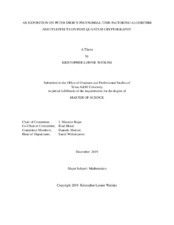| dc.contributor.advisor | Rojas, Joseph M | |
| dc.contributor.advisor | Masri, Riad | |
| dc.creator | Watkins, Kristopher Lonnie | |
| dc.date.accessioned | 2020-08-26T20:11:39Z | |
| dc.date.available | 2020-08-26T20:11:39Z | |
| dc.date.created | 2019-12 | |
| dc.date.issued | 2019-10-30 | |
| dc.date.submitted | December 2019 | |
| dc.identifier.uri | https://hdl.handle.net/1969.1/188811 | |
| dc.description.abstract | When building cryptosystems, cryptographers focus on finding problems that are not believed to be solvable in polynomial-time. Some of the most popular problems they have found are the Discrete Logarithm Problem and Integer Factoring. The former is used in Diffie-Hellman Key Exachange (DHK) and El Gamal encryption, while the latter is used in RSA. El Gamal and DHK are both very popular, but RSA is more prevalent due to its efficiency.
Nevertheless, it is plausible that in the next few decades, all three of these systems will likely be useless due to the advances made by Peter Shor in quantum computing. This paper will explain the details of how Shor’s algorithm works and how it accomplishes the above. It will also feature a redesign of the proof of Jeffrey Miller (1975) that efficiently reduces from order finding in a group of order N to factoring N. Hopefully, doing so will aid future students in their studies of quantum algorithms and Post-Quantum Cryptography. | en |
| dc.format.mimetype | application/pdf | |
| dc.language.iso | en | |
| dc.subject | Post-Quantum Cryptography | en |
| dc.title | An Exposition on Peter Shor's Polynomial-Time Factoring Algorithm and Its Effects on Post-Quantum Cryptography | en |
| dc.type | Thesis | en |
| thesis.degree.department | Mathematics | en |
| thesis.degree.discipline | Mathematics | en |
| thesis.degree.grantor | Texas A&M University | en |
| thesis.degree.name | Master of Science | en |
| thesis.degree.level | Masters | en |
| dc.contributor.committeeMember | Mortari, Daniele | |
| dc.type.material | text | en |
| dc.date.updated | 2020-08-26T20:11:40Z | |
| local.etdauthor.orcid | 0000-0002-3363-2990 | |


